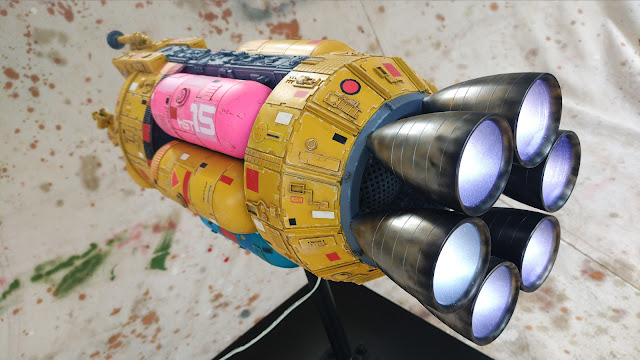Way back in October 2016 I started the container spaceship project series (which is still ongoing). In this first part I detailed the making of the engine section which although very nearly complete in terms of construction was ultimately rejected for a new design much more in keeping with the original inspiration.
This abandoned engine section lay around for a number of years until I came up with an idea to use it for a large tanker spaceship in September 2021. This was prior to starting the Merchant Vessel project. In fact I started building a front section for this tanker ship which you may recognize, it actually became the inspiration for the just completed Heavy Salvage Tug. It, like so many other sections of spaceships I design and construct was rejected for its initial purpose and re-used elsewhere for an entirely different ship.
You can see the original design thumbnail below. I followed it up with a 2D CAD drawing to figure out the sizes of all the components.
 |
Original rough design thumbnail drawing.
|
 |
2D CAD layout drawing.
|
The abandoned engine section constructed for the container ship was basically complete and just needed some way to join it to the rest of the tanker ship's spine. I ended up using a couple of molded plastic speaker ports one for the engine module and one for the eventually rejected dome front end. The speaker ports had slots cut into them so they could slide over the cross shaped wooden spine.
The spine was built from pine wood with 15mm water pipe fittings for a mount top and bottom. The water pipe mount was secured using a liberal amount of baking soda and thin super glue. many lightening holes were cut using a hole saw on a drill press.

The pictures show the original layout with the soon to be rejected front end and the engine module in place.
The spine was then covered with 1mm thick styrene sheet glued on with thick super glue. I only covered the areas that would be visible once the tanks are in place. Holes were made in the wooden spine to route the 12 volt lighting wires.
You can see above that I added the edge banding strips of styrene first and then added the outer skin leaving a degree of overlap. This overlap is then planed off using the edge of a steel ruler and sanded with fine grit sanding stick leaving a very tidy invisible join.
The tanks were made from lengths of 100mm PVC storm water pipe, although the actual OD is more like 110mm. The vessel ends on the tanks were made from cheap battery push lights from the hardware store. The inner shallow domes were pretty close to the exact diameter of the PVC tubing. The lights were disassembled and the domes cut down using a simple wooden jig on the bandsaw. These were then superglued to the ends of the PVC tube.
The picture below shows the lights as they come on the left and the part once cut on the bandsaw on the right.
Some method to retain the tanks was designed, all the parts cot out in styrene sheet and then assembled and glued together. These retainers are designed to sit over the central spine top and bottom. Styrene strips were then glued on the PVC tanks to line up with these retainers so it looks like some sort of strap system. Like the Heavy Salvage Tug the tanks will be painted different colours to seem as if they are a standard shipping vessel and come from various sources, much like the shipping containers of today.
Previous photos were all taken on the old workshop in 2021. The following photos are recent and taken in the new workshop.
Finally I ended up rejecting the front end as I felt it did not really match the engine section. Alternatively my parents asked me if I could use their old broken coffee machine. It usually depends on whether it has an interesting shape and whether it is made from a useful plastic and luckily for me it passed both tests, made from ABS and crucially suggested an interesting front end for this spaceship.
The model will be at 1/48 scale and will measure around 1240mm which in the ancient mystical measurements of the imperial druids is just over 4 feet (nearly 49 inches).
All the work described so far happened in 2021 before September when I started the Merchant Vessel project.
Thanks for looking.
More soon...












































































